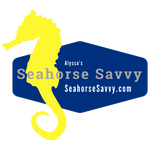Dwarf Seahorses-Setting up a Proper Aquarium

Setting up an aquarium specifically designed for your Dwarf seahorses, Hippocampus zosterae, is key to success. These tiny little seahorse are hardy given the proper environment for them to thrive.



Aquarium Size
Dwarf seahorses are very small at only about 1-1.5 inches long as full size mature adults. They do not need a lot of space to thrive. Because of their live food feeding requirements and grazing habits having a small aquarium typically works best. Keeping your dwarf seahorses in a smaller aquarium will help keep the live baby brine shrimp food concentrated.
We recommend having an aquarium in the 3-10 gallon range. 10 gallons would be recommend for very large herds of dwarf seahorses.
Husbandry and Filtration
With such a small aquarium size large water changes will be easy to accomplish in a Dwarf seahorse tank. Every system is different and one will need to check their water parameters regularly. In a small aquarium water parameters can quickly swing.
In general ~25-50% weekly water changes will be required to maintain high water quality in your dwarf seahorse aquarium. Every system is different and how much water and how frequently you change water will depend on your filtration and stocking density.
Like all of our seahorse species we highly recommend keeping your aquarium temperature between 70-74 F. This lower temperature range will help keep nasty bacterial counts low such as Virbrio spp. This is extremely important for long term success. If your aquarium is running warm a clip-on fan blowing over the surface will usually cool it down a few degrees. For other recommended water parameters please refer to our seahorse care page on the home page of our website.
Filtration
There many ways to successfully setup a dwarf seahorse aquarium. We recommend having plenty of biological filtration. Our favorite media we use in-house is MarinePure media. This provides a great surface area for beneficial nitrifying bacteria to populate.
A hang on the back filter will work. Filter floss is great to use in the filter as it can be changed out often. You may need to cover the intake on the filter with some sort of netting or mesh so your dwarf seahorses do not get stuck.

We really like some of the All-In-One tanks in the market with false backs behind which filtration compartments are housed. These have a really clean look and the back compartment is great for adding additional bio-media and mechanical filtration such as carbon and granular ferric oxide.

Substrate
We prefer bare-bottom (no sand) in all of our seahorse aquariums. We find it much easier to keep our systems clean with no sand. This is a personal preference and if you like sand you can certainly use it with your dwarf seahorses. Fine aragonite in the 1-2 mm range substrate works well rather than coarse crushed coral. Coarse substrate tends to trap waste over time creating an unhealthy environment.
One thing to consider when choosing whether to go bare-bottom or with sand is there is some risk with adding unwanted hydroids to the system when adding sand and liverock. These are small anemone like organisms that can outbreak in a system and possibly sting your small dwarf seahorses and their fry. Panacur is one treatment for these but it does not always work and they can be different to get rid of once in a system. If you do not have sand and liverock you will want to make sure you have plenty of ceramic media for biological filtration.
Hitching Posts and Tank Mates
Dwarf seahorses prefer thin diameter hitching posts typically under a quarter inch in diameter. Live hitching posts such as macro algae or live Gorgonians (sea fans) or artificial coral decorations can be used. Artificial decorations are easy to switch out and clean. Live macro algae and Gorgonians are beautiful and a lot of fun to keep. They come in a variety of shapes and colors and can make for an amazing display. One thing to keep in mind is there is a possibility of adding hydroids to your aquarium anytime you add any live corals or macroalgae.
Feeding
Dwarf seahorse unlike most other species need to graze and feed slowly throughout the day. This means you will want to have a constant supply of live enriched baby brine shrimp to feed them. Having a way to bypass the mechanical filtration during the day when feeding is helpful. For example, if you have a hang on the back filter with filter floss you can run it with no filter floss during the day so the baby shrimp stay in the system. At night you can add the filter floss for mechanical filtration and to pull out left over food.
You will also want to make sure your water flow is dialed in properly. You do not want it too high as you want your dwarf seahorses to be able to catch their food and not struggle to swim. You also do not want it to be too low. Moderate water flow is what we recommend.
For information on how to provide your dwarf seahorses with live baby brine shrimp please check out our article "Hatching Artemia (Baby Brine Shrimp) for Dwarf Seahorses and Seahorse Fry".
We hope you find this information helpful. If you have any specific questions about setting up your system for Dwarf seahorses feel free to reach out to us. We want you to be successful at keeping them and are more than happy to help. Call 410-618-3604 or email orders@seahorsesavvy.com with any questions.
